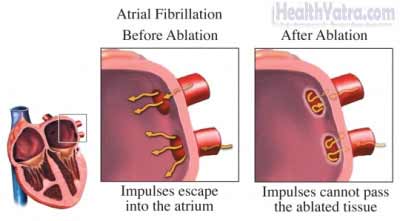تعريف
Radiofrequency ablation uses heat to destroy abnormal tissue.
أسباب هذا الإجراء
Radiofrequency ablation is used to treat:
- Cancerous tumors in the liver, bone, kidney, breast, lung, or adrenal gland, particularly those that have not responded, or are unlikely to respond to surgery and/or chemotherapy alone (often used to treat tumors that have spread)
- Cardiac arrhythmias (irregular and/or rapid heart rhythms due to abnormal electrical conduction pathways)
- Benign prostatic hyperplasia (BPH) —condition in which enlarged areas of the prostate may be compressing the urethra (the tube that carries urine from the bladder out of the body)
- Overgrown areas of the soft palate that may be responsible for severe snoring and/or sleep apnea (periods of time when breathing stops during sleep)
- Pain from soft tissue tumors or disease that has spread
- Severe nerve pain
- Varicose veins

المضاعفات المحتملة
Complications are rare, but no procedure is completely free of risk. If you are planning to have ablation, your doctor will review a list of possible complications, which may include:
- عدم ارتياح
- Bruising or bleeding
- العدوى
- Lung collapse upon insertion of the probe (when the procedure involves the lung, liver, or upper kidney)
- Blood clots or damage to heart muscle or conduction pathways after procedures on the heart
- Liver abscess (small, localized collection of pus within a cavity left by the destroyed tissue)
- Damage to tissue surrounding the target area
تشمل العوامل التي قد تزيد من خطر حدوث مضاعفات ما يلي:
- Bleeding problems
- Active infection
ما يمكن توقعه
قبل الإجراء
- Your doctor may order:
- تحاليل الدم
- Electrocardiogram (EKG) —a test that records the electrical currents passing through the heart muscle
- Imaging tests like x-rays, ultrasound, or MRI
- Ask your doctor if you need to avoid eating or drinking before the procedure.
التخدير
You will most likely be given a sedative to help you relax. Local anesthesia will be used to numb the area. If this is done as part of another surgery, you may have general or spinal anesthesia.
وصف الإجراء
An IV will be placed to give you fluids and medicine to help you relax. Your heart rate, breathing, and blood pressure will be monitored. The area where the probe will be inserted is numbed.
The probe will be inserted into or directly up against the abnormal tissue. CT, ultrasound, or MRI images may be used to help guide the probe. In some cases, once the probe is inserted, a number of electrodes will be placed into the area. This will let the doctor treat a larger area of tissue.
A small amount of heat will be introduced through the probe. The heat will destroy the abnormal tissue. The probe may be repositioned to destroy other areas of tissue.
مباشرة بعد الإجراء
You will be monitored for 2-3 hours after the procedure.
كم من الوقت سيستغرق ؟
About 10-60 minutes
كم هو مؤلم ؟
Anesthesia will prevent pain during the surgery. You will be given medicine to help prevent most pain or discomfort.
متوسط الإقامة في المستشفى
It may be possible to leave the مستشفى on the same day of the procedure. You may need to stay overnight for your doctor to monitor you. Speak to your doctor to see if this is an option in your case.
رعاية ما بعد العملية
Do not drive within the first 24 hours after the procedure. You may be asked to avoid strenuous activities. Be sure to follow your doctor’s instructions .
استدعاء الطبيب
بعد مغادرة المستشفى، اتصل بطبيبك في حالة حدوث أي مما يلي:
- علامات الإصابة, بما في ذلك حمى وقشعريرة
- احمرار أو تورم أو ألم متزايد أو نزيف شديد أو أي إفرازات من موقع الشق
- ألم لا يمكنك السيطرة عليه بالأدوية التي أعطيت لك
- Cough, shortness of breath, heart palpitations, or chest pain
- استفراغ و غثيان
في حالة الطوارئ ، اتصل على المساعدة الطبية على الفور.
